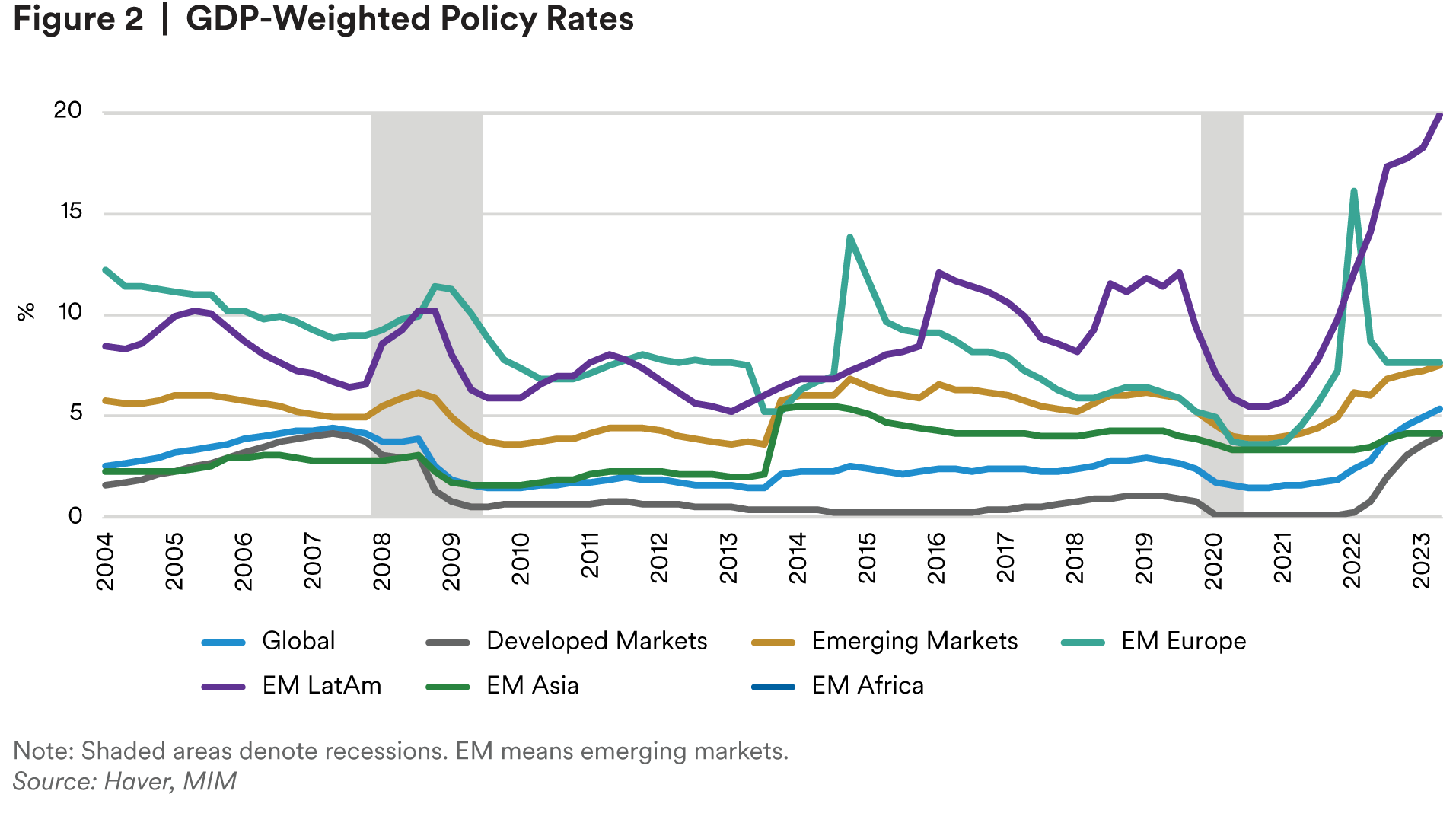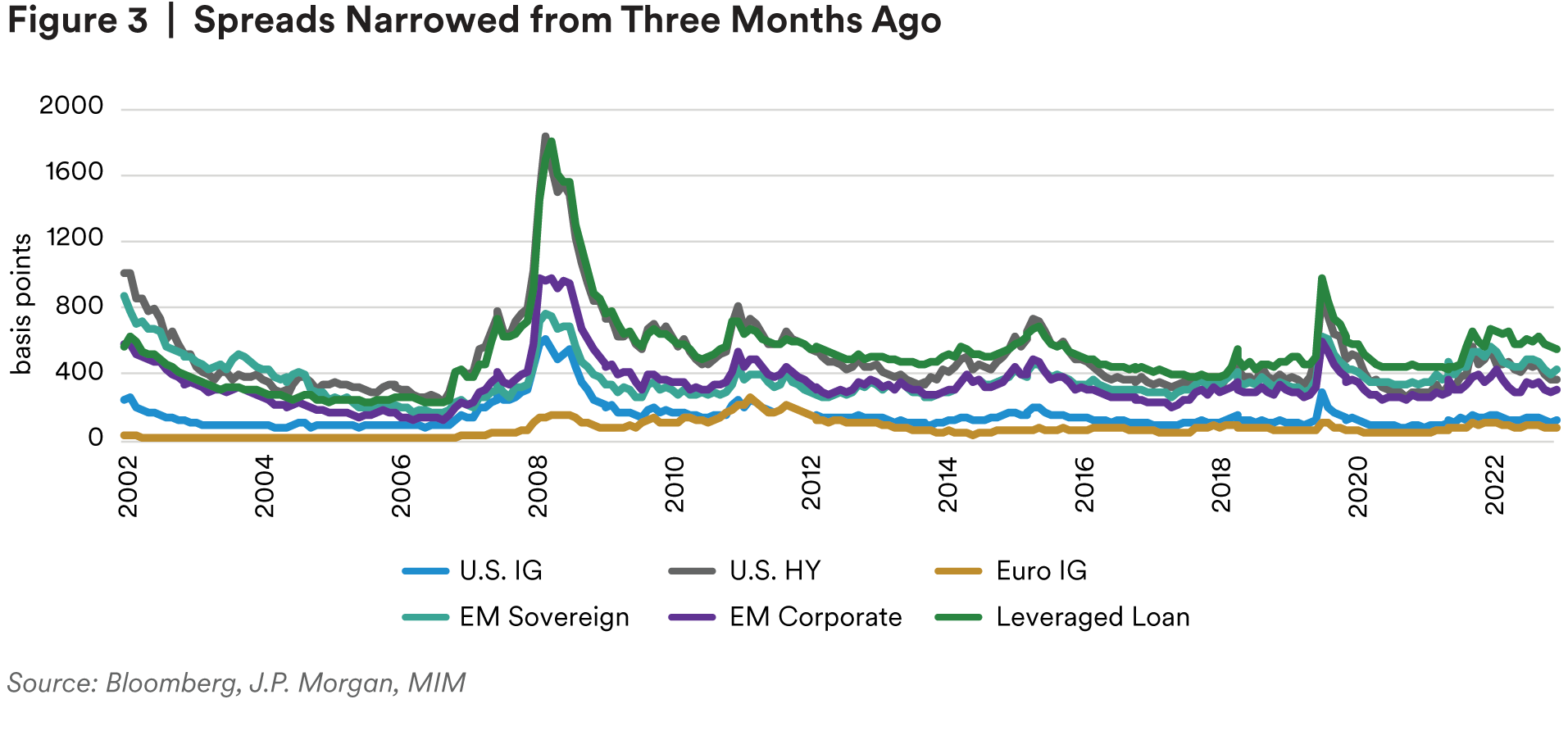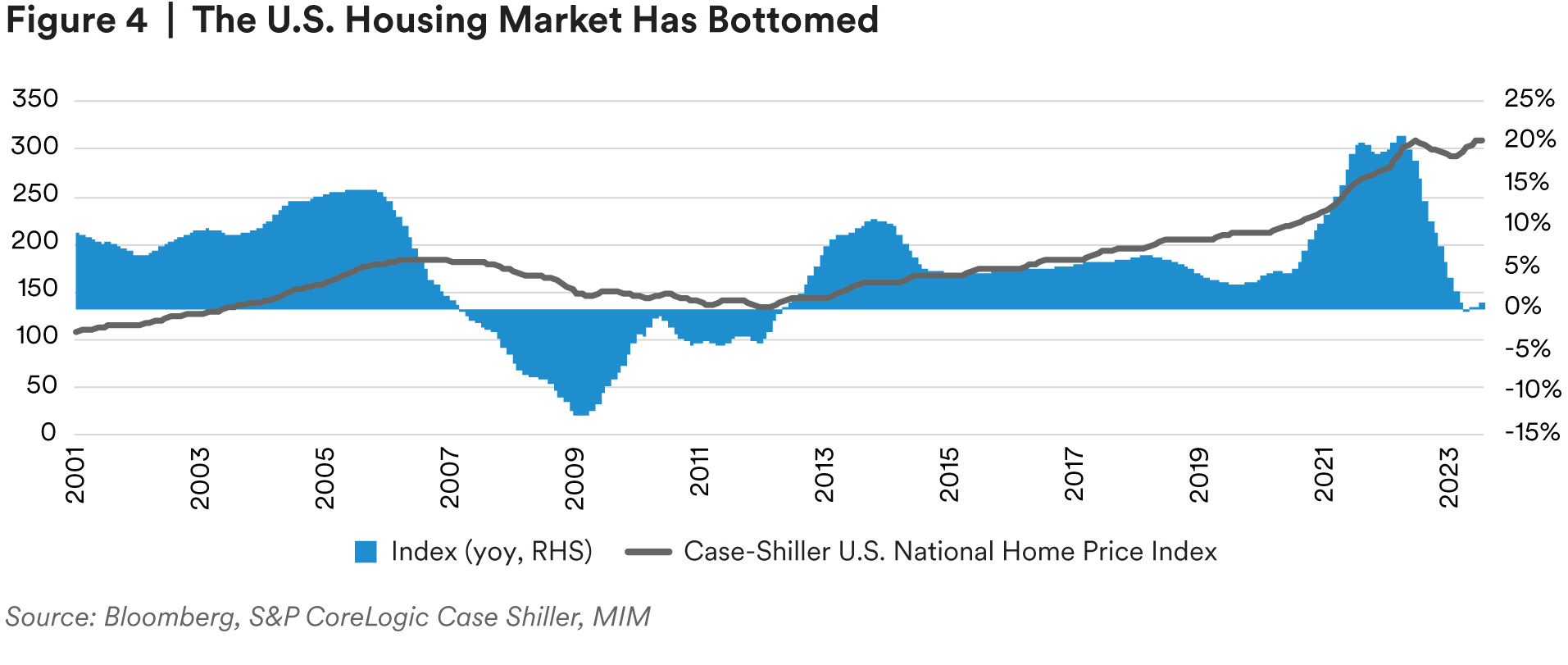Global Economy to Slow Further
Divergence in global monetary policy has become more obvious, with emerging economies cutting interest rates (see Figure 2). U.S.—We look for a U.S. recession to begin in 2024. 2023 is expected to continue to show mixed growth messages as consumer spending is anticipated to continue offsetting weakness in the manufacturing sector. Europe—Growth continues to weaken due to China’s slower-than-expected growth, energy, the lagged impacts of policy tightening, and waning fiscal support. Asia—The lagged effects of tighter monetary policy have begun to emerge against a backdrop of slowing global growth, but Asia is expected to be a global growth outperformer this year. Latin America—The region’s economic activity surprised to the upside in 1H23 in Mexico and Brazil, but the growth, like other regions, is expected to decelerate.

Slower Growth May Mean Lower Yields
U.S. Treasury (UST)—The 10-year yield is expected to move lower over the next several months; we look for the yield curve to shift downward and remain inverted. Japanese Government Bonds (JGBs)—A growth slowdown in Japan’s export markets and our expectation for the Federal Reserve (Fed) to cut interest rates next year may put more downward pressure on global government bond yields, helping the BoJ to reduce its JGB purchases. Chinese Government Bonds (CGBs)—Local government special bond issuance seems unlikely to cheapen CGBs due to ample liquidity. If Beijing undertakes a debt swap program in 4Q23, we believe it is unlikely to have a material impact on CGB yields. German Bunds—Bunds remain fundamentally supported by strong demands for high-quality euro sovereign papers.

Valuation Risks Across Credit Markets Remain High
The credit market recovered further during the summer as spreads tightened (see Figure 3) with low-quality corporate bonds outperforming. Corporate earnings were resilient and beat expectations. With headline inflation continuing to improve, the soft-landing narrative became louder. However, we believe the market is overly optimistic about the soft-landing scenario, and valuation risks across credit markets remain high. Historically speaking, when the Fed is done tightening, rates have usually peaked. Therefore, we believe it is now better to take duration rather than credit risk, and we continue to recommend “up-in-quality” for the remainder of 2023. U.S. Investment Grade (IG)—Credit fundamentals continued deteriorating moderately. After the banking issue earlier in 2023, confidence about the U.S. banking system gradually recovered. We think overall IG spreads are fairly valued. With IG yields climbing to the highest levels since 2009, we believe the current yield levels are attractive.

European IG—Fundamentals weakened moderately in the second quarter of 2023. Although earnings were better than anticipated, downside risks remained. The energy sector, a strong performer from last year, reversed to be an underperformer in 2Q23. We look for European IG’s fundamentals to continue to weaken in the coming quarters. High Yield (HY)—Like other asset classes, HY’s fundamentals deteriorated further in 2Q23, with bond recovery declining to near its five-year low. Moody’s expects the U.S. speculative-grade default rate to rise to 5.6% in January 2024 and then ease to 4.6% by August 2024. Leveraged Loans—Recovery rates remain persistently lower than historical averages. Moody’s rating migration outlook remained negative, with the one-year forward downgrade probability for single-B issuers still elevated. Municipals—Credit fundamentals were stable for both general obligations (GOs) and revenue bonds in 2Q23. For GOs, total state and local government tax revenue declined 8.9% in real terms year over year (yoy) in 1Q23, according to Urban Institute’s State Tax and Economic Review, while property tax revenues expanded by 0.4% yoy. We expect state budgets to increase 2.5% next year. For revenue bonds, the healthcare sector’s operating cash flow margins recovered in 2Q23, based on MIM’s internal data, but are still below the pre-pandemic level. Emerging Market (EM) IG—Despite the growth slowdown during 2Q23, we look for EM growth to rebound in 2H23 and Asia to outperform EMEA and LatAm. In China, the macro backdrop continued to fade amid a broad-based slowdown in its domestic demand and a faint property sector. For EM corporates, fundamentals also weakened moderately. We look for the leverage ratio to trend higher as EBITDA may remain pressured. EM banks’ loan growth slowed due to elevated interest rates, and we expect savings to increase and borrowing to decrease in the short term.
The U.S. Housing Market Has Bottomed?
Residential Credit—Mortgage rates continued to stay very elevated, keeping affordability measures very weak. However, we think the U.S. housing market has already hit its bottom and is recovering (see Figure 4), due to limited supply and a lack of transactions. Looking forward, changing bank capital regulations may lead banks to hold more agency MBS and less loans in the long term. Asset-backed Securities (ABS)—Consumers have managed to continue spending excess savings. Consumers with low FICO scores and young borrowers are falling behind in payments at a faster rate than other cohorts. Student loan payments are expected to begin shortly, adding more stress to consumers who are not making payments for three years. Collateralized Loan Obligations (CLOs)— Fundamentals within the bank loan market have not improved, with higher weighted-average risk factors (WARFs) and elevated shares of CCC within CLO portfolios. We have noticed that a resurgence in refinancing and reset transactions has begun. Recovery rates continue to be very low and are anticipated to remain below long-term averages for some time.

Commercial Mortgage-backed Securities (CMBS)—Fundamentals continued to be challenged. Most indices of National Council of Real Estate Investment Fiduciaries (NCREIF) were showing steep declines, with the office sector down 15% yoy. With the lending environment still under stress, we are seeing significant consolidations in average number of loans in a deal. Due to higher delinquencies, appraisals are being released. We look for many key properties in large cities to be down significantly more than indices indicated. Agency MBS—Higher interest rates, elevated volatility and a lack of bank demand remain a headwind for Agency MBS. Prepayment activity is muted, while mortgage originations remain at low levels. FDIC bank liquidations of specified pools have been completed, which may improve the supply picture going forward. Private Structured Credit—Performance in the prime consumer segment remains healthy. Delinquencies and defaults in the subprime borrower cohort have largely stabilized at or slightly above long-run historical averages. However, we remain cautious of the subprime segment as its performance may deteriorate further if unemployment were to rise in a recession scenario.
Office Continues to be the Most Concerning Sector
Real estate values have been repriced throughout the year, due to the high interest rate environment and the macroeconomic outlook. Vacancies continue moderating but remain well below historical long-term averages across many property types. Office remains the most concerning sector with another period of negative net leased space. Overall fundamentals seem to remain healthy. Both debt originations and equity transaction volumes continued declining, and we expect the trend to persist for some time.
Agriculture Fundamentals Remain Healthy
Net farm income is projected to be lower due to moderating annual crop market prices but still remains 39% above the long-term average, according to the United States Department of Agriculture, thanks to declining input expenses (e.g., fertilizer, diesel). Agricultural mortgage borrowers’ financial positions continue to remain healthy due to multiple years of robust farm incomes and strong growth in farmland values. We think that tight global stocks may help maintain annual crop prices above the 10-year average. The ongoing Russia-Ukraine War and the Black Sea Grain Initiative (BSGI) suspension are anticipated to disrupt grain export flows from the Black Sea, potentially creating trade opportunities for the U.S. grain exports. While the agricultural credit delinquencies remain low, the rising interest rate environment is taming the debt demand.
Corporate Equity May be Overvalued While Cash Seems Attractive
The S&P 500 equity risk premium (ERP) has been surprisingly below the U.S. IG option-adjusted spread (OAS) since late June this year (see Figure 5) and is at its lowest level in decades. This may suggest that stock investors have priced in an expectation that is even better than the soft[1]landing scenario. We believe that current equity valuations are too high, comparing to current macro fundamentals, which we think may not be sustainable. We continue to remain underweight corporate equity from a relative value perspective. Thanks to the high interest rate environment, the yield on 3-month U.S. Treasury bills is at a multi-decade high. As monetary policy will likely stay restrictive in the near future, we continue to consider cash investments relatively attractive.

Disclaimer
This material is intended solely for Institutional Investors, Qualified Investors and Professional Investors. This analysis is not intended for distribution with Retail Investors.
This document has been prepared by MetLife Investment Management (“MIM”)1 solely for informational purposes and does not constitute a recommendation regarding any investments or the provision of any investment advice, or constitute or form part of any advertisement of, offer for sale or subscription of, solicitation or invitation of any offer or recommendation to purchase or subscribe for any securities or investment advisory services. The views expressed herein are solely those of MIM and do not necessarily reflect, nor are they necessarily consistent with, the views held by, or the forecasts utilized by, the entities within the MetLife enterprise that provide insurance products, annuities and employee benefit programs. The information and opinions presented or contained in this document are provided as of the date it was written. It should be understood that subsequent developments may materially affect the information contained in this document, which none of MIM, its affiliates, advisors or representatives are under an obligation to update, revise or affirm. It is not MIM’s intention to provide, and you may not rely on this document as providing, a recommendation with respect to any particular investment strategy or investment. Affiliates of MIM may perform services for, solicit business from, hold long or short positions in, or otherwise be interested in the investments (including derivatives) of any company mentioned herein. This document may contain forward-looking statements, as well as predictions, projections and forecasts of the economy or economic trends of the markets, which are not necessarily indicative of the future. Any or all forward-looking statements, as well as those included in any other material discussed at the presentation, may turn out to be wrong.
All investments involve risks including the potential for loss of principle and past performance does not guarantee similar future results. Property is a specialist sector that may be less liquid and produce more volatile performance than an investment in other investment sectors. The value of capital and income will fluctuate as property values and rental income rise and fall. The valuation of property is generally a matter of the valuers’ opinion rather than fact. The amount raised when a property is sold may be less than the valuation. Furthermore, certain investments in mortgages, real estate or non-publicly traded securities and private debt instruments have a limited number of potential purchasers and sellers. This factor may have the effect of limiting the availability of these investments for purchase and may also limit the ability to sell such investments at their fair market value in response to changes in the economy or the financial markets.
In the U.S. this document is communicated by MetLife Investment Management, LLC (MIM, LLC), a U.S. Securities Exchange Commission registered investment adviser. MIM, LLC is a subsidiary of MetLife, Inc. and part of MetLife Investment Management. Registration with the SEC does not imply a certain level of skill or that the SEC has endorsed the investment advisor.
This document is being distributed by MetLife Investment Management Limited (“MIML”), authorised and regulated by the UK Financial Conduct Authority (FCA reference number 623761), registered address 1 Angel Lane, 8th Floor, London, EC4R 3AB, United Kingdom. This document is approved by MIML as a financial promotion for distribution in the UK. This document is only intended for, and may only be distributed to, investors in the UK and EEA who qualify as a “professional client” as defined under the Markets in Financial Instruments Directive (2014/65/EU), as implemented in the relevant EEA jurisdiction, and the retained EU law version of the same in the UK.
For investors in the Middle East: This document is directed at and intended for institutional investors (as such term is defined in the various jurisdictions) only. The recipient of this document acknowledges that (1) no regulator or governmental authority in the Gulf Cooperation Council (“GCC”) or the Middle East has reviewed or approved this document or the substance contained within it, (2) this document is not for general circulation in the GCC or the Middle East and is provided on a confidential basis to the addressee only, (3) MetLife Investment Management is not licensed or regulated by any regulatory or governmental authority in the Middle East or the GCC, and (4) this document does not constitute or form part of any investment advice or solicitation of investment products in the GCC or Middle East or in any jurisdiction in which the provision of investment advice or any solicitation would be unlawful under the securities laws of such jurisdiction (and this document is therefore not construed as such).
For investors in Japan: This document is being distributed by MetLife Asset Management Corp. (Japan) (“MAM”), 1-3 Kioicho, Chiyoda-ku, Tokyo 102-0094, Tokyo Garden Terrace KioiCho Kioi Tower 25F, a registered Financial Instruments Business Operator (“FIBO”) under the registration entry Director General of the Kanto Local Finance Bureau (FIBO) No. 2414.
For Investors in Hong Kong S.A.R.: This document is being issued by MetLife Investments Asia Limited (“MIAL”), a part of MIM, and it has not been reviewed by the Securities and Futures Commission of Hong Kong (“SFC”). MIAL is licensed by the Securities and Futures Commission for Type 1 (dealing in securities), Type 4 (advising on securities) and Type 9 (asset management) regulated activities.
For investors in Australia: This information is distributed by MIM LLC and is intended for “wholesale clients” as defined in section 761G of the Corporations Act 2001 (Cth) (the Act). MIM LLC exempt from the requirement to hold an Australian financial services license under the Act in respect of the financial services it provides to Australian clients. MIM LLC is regulated by the SEC under US law, which is different from Australian law.
MIMEL: For investors in the EEA, this document is being distributed by MetLife Investment Management Europe Limited (“MIMEL”), authorised and regulated by the Central Bank of Ireland (registered number: C451684), registered address 20 on Hatch, Lower Hatch Street, Dublin 2, Ireland. This document is approved by MIMEL as marketing communications for the purposes of the EU Directive 2014/65/EU on markets in financial instruments (“MiFID II”). Where MIMEL does not have an applicable cross-border licence, this document is only intended for, and may only be distributed on request to, investors in the EEA who qualify as a “professional client” as defined under MiFID II, as implemented in the relevant EEA jurisdiction. The investment strategies described herein are directly managed by delegate investment manager affiliates of MIMEL. Unless otherwise stated, none of the authors of this article, interviewees or referenced individuals are directly contracted with MIMEL or are regulated in Ireland. Unless otherwise stated, any industry awards referenced herein relate to the awards of affiliates of MIMEL and not to awards of MIMEL.
1 As of March 31, 2023, subsidiaries of MetLife, Inc. that provide investment management services to MetLife’s general account, separate accounts and/or unaffiliated/third party investors include Metropolitan Life Insurance Company, MetLife Investment Management, LLC, MetLife Investment Management Limited, MetLife Investments Limited, MetLife Investments Asia Limited, MetLife Latin America Asesorias e Inversiones Limitada, MetLife Asset Management Corp. (Japan), MIM I LLC, MetLife Investment Management Europe Limited, Affirmative Investment Management Partners Limited and Raven Capital Management LLC





